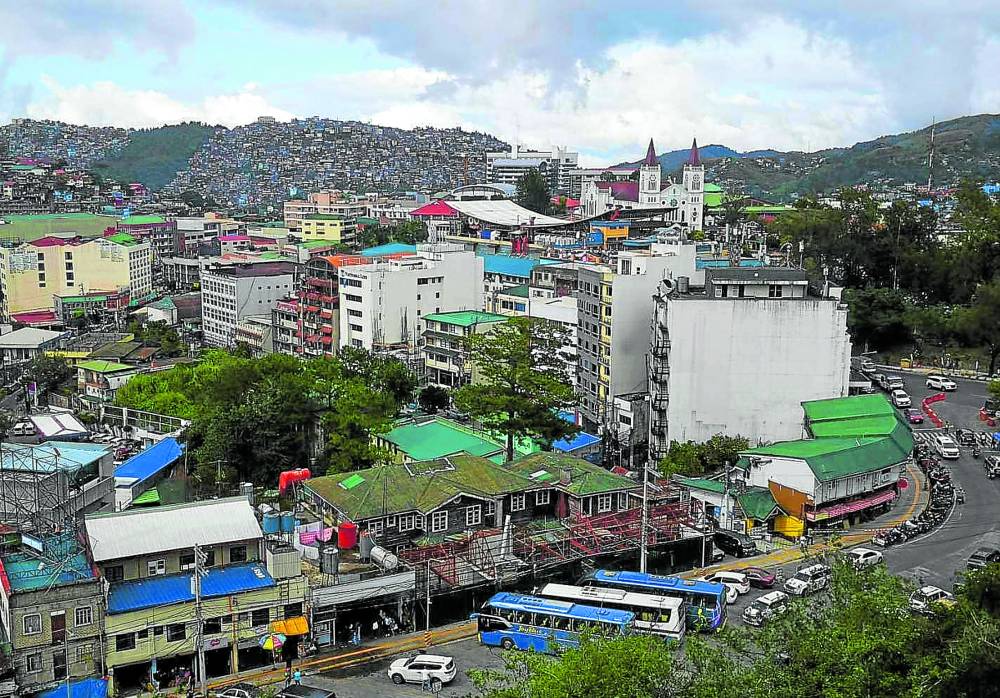In Baguio, new quake maps to help spot danger zones

UPLAND BOOM Baguio City has risen from the devastation of the killer earthquake that struck northern Luzon in 1990. Today, the summer capital is dealing with the impact of overdevelopment and population growth, prompting local officials to find ways to protect the city’s remaining resources and ensure that its residents are safe from natural disasters. —EV ESPIRITU
BAGUIO CITY — A more comprehensive study of the city’s vulnerability to earthquakes was released to the local government last week to help refine its building and land use policies.
The “ground shaking hazard maps” were generated by the Philippine Institute of Volcanology and Seismology (Phivolcs), said Nancy Bantog, Cordillera director of the Department of Science and Technology, at the maps’ launching program on Sept. 8.
She said the maps outline the potential impact on structures already standing or being put up in areas that might suffer from severe ground shaking during earthquakes.
Baguio was devastated by the July 16, 1990, Luzon earthquake and had to be rebuilt for the second time since 1945, when American bombers fighting the Japanese flattened the city toward the end of World War II.
“The epicenter [of the magnitude 7.7 earthquake in 1990] was in Rizal, Nueva Ecija, but Baguio was severely affected [because of] ground shaking, not ground failure,” said Teresito Bacolcol, Phivolcs officer in charge.
Experts have concluded that the wave of destruction in 1990 corresponded with the escalation of ground movement, Bacolcol added.
This means that unusually strong shaking led to the collapse or the fracturing beyond repair of buildings and other structures when the Philippine Fault and the Digdig Fault moved 32 years ago.
The new Baguio maps measure the potential acceleration rate of ground shaking throughout the city, with high vulnerabilities detected in pockets of the city’s Pacdal and Gibraltar communities in Barangay Lualhati, said Rhommel Grutas, Phivolcs’ supervising science research specialist, at the launch. These areas are familiar to tourists who frequent the presidential Mansion and Mines View Park.
Ground shaking may also be high in parts of Barangays Loakan and Apugan near Camp John Hay forest reserve should a high-magnitude tremor strike, he said.
3D version
Bacolcol said the study measured the “shear wave velocity” of Baguio. Ground shaking is minimal when the velocity, which relies on the soil and terrain, is high.
The study also established the “period of ground motion” for each part of the city, to identify a “site amplification factor” or standard engineering value.
Grutas said the new data was not meant to scare people away from Baguio. Instead, the maps are references for structural engineers to build stronger hotels, office buildings or residences, he said.
The new data would alter the city’s comprehensive land use plan, which is being updated, said architect Donna Tabangin, city planning and development officer, who received the new maps from Phivolcs.
She said the Phivolcs data may also reconfigure a Baguio digital three-dimensional “twin” that models the growth rate of population and infrastructure density as well as the actual condition of Baguio’s remaining natural resources to help the city plan for the future.
Initiated in 2020, the “Baguio Twin” was generated using available engineering, public service and population data, as well as the city’s geological hazards and profiles of its terrain. —WITH A REPORT FROM KIMBERLIE QUITASOL